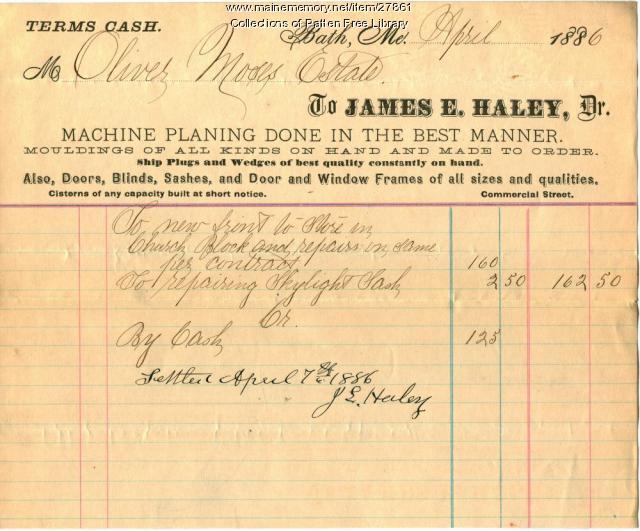Keywords: Industrial Architecture
Item 6149
Contributed by: Maine Historical Society Date: 1929 Location: Bingham; Moscow Media: Architectural drawing
Item 27861
Haley bill for Church Block, Bath, 1886
Contributed by: Patten Free Library Date: 1886-04-07 Location: Bath Media: Ink on paper
Item 150233
Northern Chemical Industries superphosphate plant, Searsport, 1943-1944
Contributed by: Maine Historical Society Date: 1943–1944 Location: Searsport Client: Northern Chemical Industries Inc. Architect: Eaton W. Tarbell
Item 150221
Northern Chemical Industries Inc. - alterations to lean-to offices, Searsport, 1944
Contributed by: Maine Historical Society Date: 1944 Location: Searsport Client: Northern Chemical Industries Inc. Architect: Eaton W. Tarbell
Exhibit
The Barns of the St. John River Valley: Maine's Crowning Jewels
Maine's St. John River Valley boasts a unique architectural landscape. A number of historical factors led to the proliferation of a local architectural style, the Madawaska twin barn, as well as a number of building techniques rarely seen elsewhere. Today, these are in danger of being lost to time.
Exhibit
In Time and Eternity: Shakers in the Industrial Age
"In Time and Eternity: Maine Shakers in the Industrial Age 1872-1918" is a series of images that depict in detail the Shakers in Maine during a little explored time period of expansion and change.
Site Page
Architecture & Landscape database - John Calvin Stevens
"… 1889 book “Examples of American Domestic Architecture.” John Calvin Stevens is one of the best documented figures in Maine architectural history…"
Site Page
Architecture & Landscape database - Eaton W. Tarbell
"… Bowdoin in 1937, he enrolled in the Department of Architecture at the Harvard Graduate School of Design."
Story
History of Forest Gardens
by Gary Libby
This is a history of one of Portland's oldest local bars
Lesson Plan
Longfellow Studies: "The Jewish Cemetery at Newport"
Grade Level: 6-8, 9-12
Content Area: English Language Arts, Social Studies
Longfellow's poem "The Jewish Cemetery at Newport" opens up the issue of the earliest history of the Jews in America, and the significant roles they played as businessmen and later benefactors to the greater community. The history of the building itself is notable in terms of early American architecture, its having been designed, apparently gratis, by the most noted architect of the day. Furthermore, the poem traces the history of Newport as kind of a microcosm of New England commercial cities before the industrialization boom. For almost any age student the poem could be used to open up interest in local cemeteries, which are almost always a wealth of curiousities and history. Longfellow and his friends enjoyed exploring cemeteries, and today our little local cemeteries can be used to teach little local histories and parts of the big picture as well.
Henry Wadsworth Longfellow visited the Jewish cemetery in Newport, RI on July 9, 1852. His popular poem about the site, published two years later, was certainly a sympathetic portrayal of the place and its people. In addition to Victorian romantic musings about the "Hebrews in their graves," Longfellow includes in this poem references to the historic persecution of the Jews, as well as very specific references to their religious practices.
Since the cemetery and the nearby synagogue were restored and protected with an infusion of funding just a couple years after Longfellow's visit, and later a congregation again assembled, his gloomy predictions about the place proved false (never mind the conclusion of the poem, "And the dead nations never rise again!"). Nevertheless, it is a fascinating poem, and an interesting window into the history of the nation's oldest extant synagogue.














